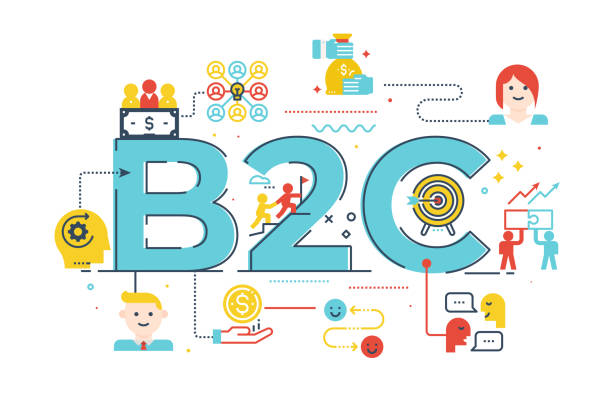The world around us is shaped by our everyday habits, most of which we are not aware of.
In B2C marketing, people don’t just buy products or take action purely because of logical presentation but based on emotional appeal, worldview biases, and current pain points. These traits are consistent among the B2C content consumers.
When your writing follows a familiar flow, mirrors their thought patterns, and reassures them at each step, you reduce friction and build trust. This ties into the psychological principle of behavioral consistency: people prefer actions and decisions that align with what they already believe or expect.
That’s why the best B2C writing feels “natural.” It speaks the way the customer already thinks, then guides them toward a decision that feels like their own.
According to Nielsen research, US adults spend nearly half their day interacting with media content. In those fleeting moments of attention, your content either resonates with deep psychological triggers or loses attention to the next brand. The brands that understand consumer psychology don’t just capture attention—they naturally lead casual readers to their intended next step.
B2C Psychological Biases and Behavioral Patterns
B2C audiences often believe they’re making decisions freely, but in reality, their choices follow predictable psychological patterns—subtly engineered by how information is presented.
Google’s research on consumer decision-making identified four key behaviors that have redefined marketing: exploration, evaluation, experience, and advocacy.
The Three Pillars of Persuasive B2C Content
1. Ethos (Credibility)
B2C customers need to trust you before they’ll buy from you. This isn’t just about testimonials—it’s about demonstrating expertise, social proof, and authority throughout your content.
For Example, A consumer is more comfortable or naturally more likely to buy a $150 Nike pair of sneakers over a cheaper Chinese brand with an unknown logo or no logo at all. Even when both shoes offer the same comfort, durability, and performance, customers gravitate toward known brands like Nike because of their established credibility.
As a startup, you wonder how this can be applied in my case? Start by borrowing credibility through strategic partnerships, customer testimonials, and industry certifications in your content writing.
They are your cumulative edge over time when competing with other brands.
2. Pathos (Emotional Connection)
B2C decisions are 95% emotional, then sprinkled with rationalization. Your content must create emotional resonance before presenting logical arguments. This is where storytelling and the common target audience experiential narrative come into play, when utilized.
Example: Nike doesn’t sell shoes—they sell the feeling of achievement. Their “Just Do It” campaigns tap into emotions of determination, self-improvement, and overcoming obstacles. Customers buy the emotional transformation they desire, not just athletic footwear.
3. Logos (Logical Framework)
Even emotional buyers need a little bit of logical justification for their decisions. Your content should provide the rational framework customers use to justify purchases to themselves and others.
Example: Apple creates emotional desire with sleek design and lifestyle positioning, but they provide logical justification through technical specifications, performance comparisons, and ecosystem compatibility. Customers feel good about their purchase of $1,200 iPhone and can rationally defend it, even when a $300 phone would meet their actual needs.
Key Psychological Biases in B2C Behavior
1. Loss Aversion
Customers fear losing something more than they value gaining something of equal worth. This drives urgency and scarcity based on message presentation.
Example: Amazon’s “Only 2 left in stock” or Booking.com’s “3 people are looking at this hotel right now” creates fear of missing out. Customers act faster to avoid losing the opportunity than they would to gain the same product.
2. Social Proof:
B2C buyers look to others like them for validation. Peer or customer reviews often can carry more weight than expert opinions in B2C contexts.
Example: When choosing a restaurant, you trust the 500 Google reviews from regular diners more than one food critic’s opinion. Similarly, Amazon shoppers scroll past professional descriptions to read customer reviews and Q&As from actual users.
3. Anchoring Bias:
The first piece of information customers encounter becomes their reference point for all subsequent decisions.
Example: Williams Sonoma introduced a $429 bread maker that barely sold. Then they added a $279 model—suddenly the $429 version became their bestseller. The higher price “anchored” customers’ expectations, making the expensive option seem reasonable by comparison.
4. Commitment Consistency:
Once customers make a small commitment, they’re psychologically driven to make larger, related commitments to remain consistent with their self-image.
Example: Duolingo starts with asking users to commit to just “5 minutes a day” of language learning. Once users see themselves as “someone who studies Spanish daily,” they’re more likely to upgrade to premium features, extend study streaks, and recommend the app to others.
B2C Areas of Application in B2C Content Writing
Now, let’s explore how these psychological insights apply across major B2C content types.
1. Product Description Psychology
Intent: Convert browsers into buyers by making products irresistible
Psychological Triggers That Move the Needle:
- Sensory Language (taps into experiential desire)
- Social Proof Integration (reduces purchase anxiety)
- Benefit-Focused Features (connects features to emotional outcomes)
- Scarcity Signals (leverages loss aversion)
⟹ Typical Sample:
“Ultra-Soft Bamboo Sheets – 100% bamboo fiber, 300 thread count, machine washable, available in 6 colors. Hypoallergenic and eco-friendly material.”
⟹ Strategic Sample:
“Transform Your Bedroom Into a 5-Star Hotel Sanctuary – Slip into cloud-like comfort with our ultra-soft bamboo sheets that over 50,000 customers call ‘life-changing.’ Feel the silky-smooth texture against your skin while knowing you’re choosing sustainable luxury. Only 3 sets left in Midnight Blue – the color that interior designers say creates the most restful sleep environment.”
⟹ Psychology in Action:
The strategic version uses pathos (emotional language like “sanctuary” and “life-changing”), ethos (social proof from 50,000 customers), and logos (sustainability and expert designer validation).
2. Email Marketing Sequences
Intent: Build relationships and drive repeat purchases through psychological engagement
Psychological Triggers That Lead to Goal Completion:
- Reciprocity Principle (free value creates the obligation to reciprocate)
- Personal Investment (getting customers to engage increases commitment)
- Urgency and Scarcity (loss aversion drives immediate action)
- Identity Reinforcement (aligning purchases with self-concept)
⟹ Typical Sample:
“Subject: Don’t Forget Your Cart Hi [Name], you left items in your cart. Complete your purchase now to get these products before they’re gone. Click here to checkout.”
⟹ Strategic Sample:
“Subject: Sarah, I’m holding your favorites (but not for long) 👀 Hi Sarah, I noticed you were exploring our bestseller collection earlier. Smart choice – you have excellent taste! I’ve reserved those items in your cart for the next 24 hours because I know how frustrating it is when something you love sells out. After that, they’ll go to the next person on our waitlist. Ready to make them yours? [Complete Your Order]”
⟹ Psychology in Action:
This version creates reciprocity by “holding” items, uses ethos through implied exclusivity, and pathos through a personalized, conversational tone that makes the customer feel special.
3. Social Media Content That Drives Action
Intent: Generate engagement, shares, and clicks that lead to conversions
Psychological Triggers That Lead to Goal Completion:
- Emotional Storytelling (creates personal connection)
- Community Building (leverages belonging needs)
- Call-to-Action Psychology (specific, clear next steps)
- Visual Psychology (images that stop scrolling and create desire)
⟹ Typical Sample:
“Our skincare products are great for all skin types. Try our new serum today! Link in bio. #skincare #beauty #glowingskin”
⟹ Strategic Sample:
“Emma tried EVERYTHING for her stubborn acne. $800 at dermatologists. Harsh chemicals that made it worse. Pinterest ‘miracle’ routines that did nothing. She was ready to give up… Then she discovered our gentle 3-step routine. 6 weeks later, she sent us this photo [transformation image]. ‘I finally feel confident without makeup,’ she wrote. What would clear, glowing skin mean to YOU? Drop a 💫 if you’re ready to try Emma’s routine. First 20 people get our starter kit for 40% off.”
⟹ Psychology in Action:
Uses pathos through Emma’s relatable struggle, ethos via transformation proof, and logos with the systematic 3-step approach. The engagement request creates commitment.
4. Landing Page Copy for Ad Campaigns
Intent: Convert paid traffic into customers by removing friction and objections
Psychological Triggers That Lead to Goal Completion:
- Attention Retention (hooks that stop the scroll)
- Urgency Creation (time-sensitive offers)
- Objection Handling (addressing fears before they arise)
- Social Validation (proof others have succeeded)
⟹ Typical Sample:
“Best Productivity App – Get More Done Download our app and increase your productivity. Features include task management, scheduling, and progress tracking. Try free for 7 days.”
⟹ Strategic Sample:
“The 5-Minute Morning Routine That’s Replacing $200 Therapy Sessions Sarah was spending $800/month on therapy and still felt overwhelmed. Then she discovered this simple morning practice that 47,000+ busy professionals use to feel centered and focused all day. In just 30 days, Sarah felt more in control than after 6 months of traditional therapy. Limited Time: Get Sarah’s complete 5-minute routine + our guided app free for 14 days (normally $29/month). Only 72 hours left at this special price. Join the thousands who’ve already transformed their mornings…”
⟹ Psychology in Action:
Strong pathos through Sarah’s relatable problem, ethos via 47,000+ user social proof, and logos with specific time frames and results. Research shows that psychological triggers can boost conversion rates by up to 300%.
5. Blog Content for Customer Education
Intent: Build trust, establish authority, and guide purchase decisions
Psychological Triggers That Lead to Action:
- Problem-Solution Framework (identifies with customer pain points)
- Authority Building (demonstrates expertise and credibility)
- Trust Signals (transparent, helpful information)
- Subtle Call-to-Actions (non-pushy next steps)
⟹ Typical Sample:
“How to Choose the Right Skincare Products. Choosing skincare products can be confusing. Here are some tips:
- Know your skin type
- Read ingredients
- Start with the basics
- Be consistent. Our products are formulated for all skin types.”
⟹ Strategic Sample:
“Why Your 10-Step Skincare Routine Is Actually Ruining Your Skin (And the Counterintuitive Fix That Actually Works)
Maria religiously followed her expensive 10-step routine. Cleanser, toner, essence, serum, moisturizer—twice daily, every day. Her skin got worse. Turns out, she was making the #1 mistake that 73% of skincare enthusiasts make: over-treating their skin barrier.
Here’s what dermatologists wish you knew about skincare minimalism… [continues with valuable educational content that naturally leads to product recommendations]”
⟹ Psychology in Action:
Creates ethos by challenging conventional wisdom with expert knowledge, uses pathos through Maria’s relatable frustration, and logos by providing scientific reasoning. Following proven blog writing strategies ensures the content serves readers while guiding them toward conversion.
Best Practices for B2C Content Writers
- Lead With Emotion, Support With Logic: B2C customers buy emotionally and justify logically. Your headlines should trigger emotions (learn more about crafting compelling headlines), while your body copy provides rational support for the emotional decision.
- Use the Rule of Three: Present information in groups of three—it’s psychologically easier to process and remember. Three benefits, three features, three testimonials.
- Create Micro-Commitments: Understanding consumer purchasing psychology reveals that small commitments lead to larger ones. Start with email signups, quizzes, or free downloads before asking for purchases.
- Layer Social Proof Strategically: Don’t just use testimonials—combine user reviews, expert endorsements, usage statistics, and peer behavior indicators for maximum psychological impact.
- Optimize for Mobile Psychology: Mobile users have different psychological states—they’re often distracted, impatient, and scroll-happy. Your content must work with these behaviors, not against them.
- Build Email Lists Psychologically: Effective email list building requires understanding the psychology of value exchange—what will people willingly trade their email address for?
Ready to Transform Your B2C Content With Psychology-Driven Writing?
The difference between content that gets ignored and content that converts isn’t creativity—it’s psychology. The examples above represent just a fraction of how behavioral science can transform your customer engagement and conversion rates.
I specialize in creating B2C content that taps into the psychological triggers that drive customer action. Every piece I write combines:
✅ Research-backed psychological principles
✅ Emotional storytelling that converts
✅ Strategic use of ethos, pathos, and logos
✅ Conversion-focused structures
✅ SEO optimization for organic reach
Whether you need product descriptions that sell, email sequences that build relationships, social content that drives action, landing pages that convert, or educational blog posts that establish authority—I create content that works with human psychology, not against it.
Start with a free trial article and see how psychology-driven content can transform your conversions. No payment required, no strings attached—just professional, results-focused writing that demonstrates the difference psychological insight makes.
Hire Me for Psychology-Driven Content Writing →
You can contact me at [email protected] to discuss your project and claim your free trial article today.






